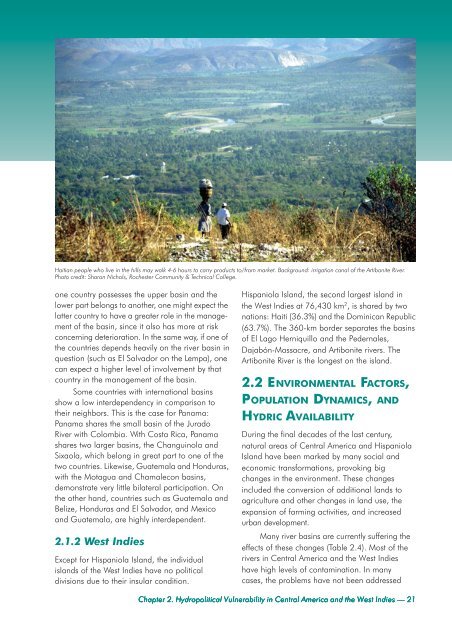Latin America; in English (pdf) - Transboundary Freshwater Dispute ...
Latin America; in English (pdf) - Transboundary Freshwater Dispute ...
Latin America; in English (pdf) - Transboundary Freshwater Dispute ...
You also want an ePaper? Increase the reach of your titles
YUMPU automatically turns print PDFs into web optimized ePapers that Google loves.
Haitian people who live <strong>in</strong> the hills may walk 4-6 hours to carry products to/from market. Background: irrigation canal of the Artibonite River.<br />
Photo credit: Sharon Nichols, Rochester Community & Technical College.<br />
one country possesses the upper bas<strong>in</strong> and the<br />
lower part belongs to another, one might expect the<br />
latter country to have a greater role <strong>in</strong> the management<br />
of the bas<strong>in</strong>, s<strong>in</strong>ce it also has more at risk<br />
concern<strong>in</strong>g deterioration. In the same way, if one of<br />
the countries depends heavily on the river bas<strong>in</strong> <strong>in</strong><br />
question (such as El Salvador on the Lempa), one<br />
can expect a higher level of <strong>in</strong>volvement by that<br />
country <strong>in</strong> the management of the bas<strong>in</strong>.<br />
Some countries with <strong>in</strong>ternational bas<strong>in</strong>s<br />
show a low <strong>in</strong>terdependency <strong>in</strong> comparison to<br />
their neighbors. This is the case for Panama:<br />
Panama shares the small bas<strong>in</strong> of the Jurado<br />
River with Colombia. With Costa Rica, Panama<br />
shares two larger bas<strong>in</strong>s, the Changu<strong>in</strong>ola and<br />
Sixaola, which belong <strong>in</strong> great part to one of the<br />
two countries. Likewise, Guatemala and Honduras,<br />
with the Motagua and Chamalecon bas<strong>in</strong>s,<br />
demonstrate very little bilateral participation. On<br />
the other hand, countries such as Guatemala and<br />
Belize, Honduras and El Salvador, and Mexico<br />
and Guatemala, are highly <strong>in</strong>terdependent.<br />
2.1.2 West Indies<br />
Except for Hispaniola Island, the <strong>in</strong>dividual<br />
islands of the West Indies have no political<br />
divisions due to their <strong>in</strong>sular condition.<br />
Hispaniola Island, the second largest island <strong>in</strong><br />
the West Indies at 76,430 km 2 , is shared by two<br />
nations: Haiti (36.3%) and the Dom<strong>in</strong>ican Republic<br />
(63.7%). The 360-km border separates the bas<strong>in</strong>s<br />
of El Lago Herniquillo and the Pedernales,<br />
Dajabón-Massacre, and Artibonite rivers. The<br />
Artibonite River is the longest on the island.<br />
2.2 ENVIRONMENTAL FACTORS,<br />
POPULATION DYNAMICS, AND<br />
HYDRIC AVAILABILITY<br />
Dur<strong>in</strong>g the f<strong>in</strong>al decades of the last century,<br />
natural areas of Central <strong>America</strong> and Hispaniola<br />
Island have been marked by many social and<br />
economic transformations, provok<strong>in</strong>g big<br />
changes <strong>in</strong> the environment. These changes<br />
<strong>in</strong>cluded the conversion of additional lands to<br />
agriculture and other changes <strong>in</strong> land use, the<br />
expansion of farm<strong>in</strong>g activities, and <strong>in</strong>creased<br />
urban development.<br />
Many river bas<strong>in</strong>s are currently suffer<strong>in</strong>g the<br />
effects of these changes (Table 2.4). Most of the<br />
rivers <strong>in</strong> Central <strong>America</strong> and the West Indies<br />
have high levels of contam<strong>in</strong>ation. In many<br />
cases, the problems have not been addressed<br />
Chapter 2. Hydropolitical Vulnerability <strong>in</strong> Central <strong>America</strong> and the West Indies — 21
















